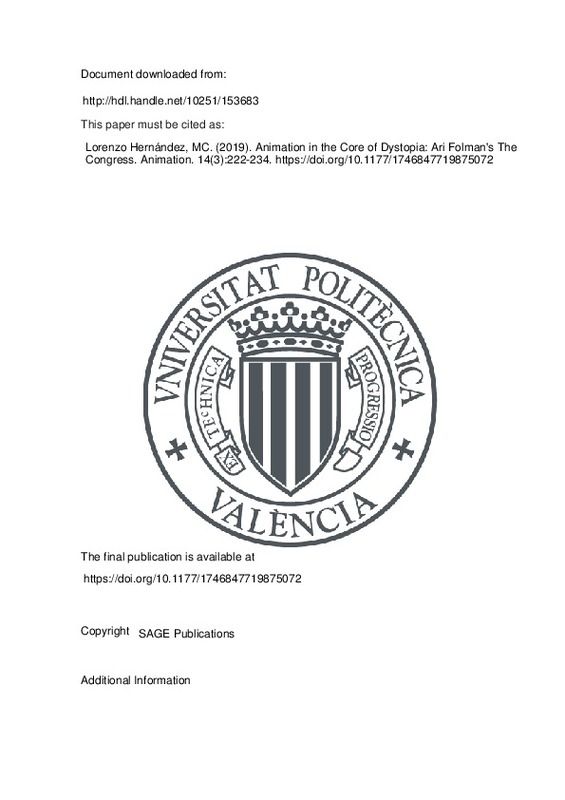JavaScript is disabled for your browser. Some features of this site may not work without it.
Buscar en RiuNet
Listar
Mi cuenta
Estadísticas
Ayuda RiuNet
Admin. UPV
Animation in the Core of Dystopia: Ari Folman's The Congress
Mostrar el registro sencillo del ítem
Ficheros en el ítem
| dc.contributor.author | Lorenzo Hernández, María Carmen
|
es_ES |
| dc.date.accessioned | 2020-10-30T04:32:15Z | |
| dc.date.available | 2020-10-30T04:32:15Z | |
| dc.date.issued | 2019-11 | es_ES |
| dc.identifier.issn | 1746-8477 | es_ES |
| dc.identifier.uri | http://hdl.handle.net/10251/153683 | |
| dc.description.abstract | [EN] Ari Folman's The Congress (2013) borrows freely from Stanisaw Lem's dystopian view in his Sci-fi novel The Futurological Congress (1971) to propose the gradual dissolution of the human into an artificial form, which is animation. By moving the action of the novel from a hypothetical future to contemporary Hollywood, Ari Folman gives CGI animation the role of catalyst for changes not only in the production system, but for human thought and, therefore, for society. This way, the film ponders the changing role of performers at the time of their digitalization, as well as on the progressive dematerialization of the film industry, considering a dystopian future where simulation fatally displaces reality, which invites relating The Congress with Jean Baudrillard's and Alan Cholodenko's theses on how animating technologies have resulted in the culture of erasing. Moreover, this article highlights how Lem's metaphor of the manipulation of information in the Soviet era is transformed in the second part of The Congress into a vision of cinema as a collective addiction, relating it to Alexander Dovzhenko's and Edgar Morin's speculative theories of total film - which come close to the potentialities of today's Virtual Reality and Augmented Reality. In addition, although The Congress is a disturbing view of film industry and animating technologies, its vision of film is nostalgically retro as it vindicates an entire tradition of Golden Age animation that transformed the star system into cartoons, suggesting the fictionalization of their lives and establishing a postmodern continuum between animation and film. | es_ES |
| dc.language | Inglés | es_ES |
| dc.publisher | SAGE Publications | es_ES |
| dc.relation.ispartof | Animation | es_ES |
| dc.rights | Reserva de todos los derechos | es_ES |
| dc.subject | Adaptation | es_ES |
| dc.subject | Ari Folman | es_ES |
| dc.subject | Holocaust | es_ES |
| dc.subject | Robin Wright | es_ES |
| dc.subject | Simulation | es_ES |
| dc.subject | Stanisaw Lem | es_ES |
| dc.subject | Star system | es_ES |
| dc.subject.classification | DIBUJO | es_ES |
| dc.title | Animation in the Core of Dystopia: Ari Folman's The Congress | es_ES |
| dc.type | Artículo | es_ES |
| dc.identifier.doi | 10.1177/1746847719875072 | es_ES |
| dc.rights.accessRights | Abierto | es_ES |
| dc.contributor.affiliation | Universitat Politècnica de València. Departamento de Dibujo - Departament de Dibuix | es_ES |
| dc.description.bibliographicCitation | Lorenzo Hernández, MC. (2019). Animation in the Core of Dystopia: Ari Folman's The Congress. Animation. 14(3):222-234. https://doi.org/10.1177/1746847719875072 | es_ES |
| dc.description.accrualMethod | S | es_ES |
| dc.relation.publisherversion | https://doi.org/10.1177/1746847719875072 | es_ES |
| dc.description.upvformatpinicio | 222 | es_ES |
| dc.description.upvformatpfin | 234 | es_ES |
| dc.type.version | info:eu-repo/semantics/publishedVersion | es_ES |
| dc.description.volume | 14 | es_ES |
| dc.description.issue | 3 | es_ES |
| dc.relation.pasarela | S\405436 | es_ES |
| dc.description.references | Eisenstein S (2011[1940–1948]) Disney. In: Bulgakowa O, Hochmuth D (eds) Sergei Eisenstein | Disney, trans. Condren D. Berlin: Potemkin Press, 9–123. | es_ES |
| dc.description.references | Feyersinger, E. (2010). Diegetic Short Circuits: Metalepsis in Animation. Animation, 5(3), 279-294. doi:10.1177/1746847710386432 | es_ES |
| dc.description.references | Hachero Hernández, B. (2015). Deformar a la Gorgona: la imagen animada como estrategia para documentar el horror. Con A de animación, (5), 114. doi:10.4995/caa.2015.3542 | es_ES |
| dc.description.references | Kriger, J. (2012). Animated Realism. doi:10.4324/9780240814407 | es_ES |
| dc.description.references | Silvio, T. (2010). Animation: The New Performance? Journal of Linguistic Anthropology, 20(2), 422-438. doi:10.1111/j.1548-1395.2010.01078.x | es_ES |
| dc.description.references | Delgado Sánchez C (2016) ¡A ver quién se anima! Actores animados, dibujos de carne y hueso. Madrid: Diábolo. | es_ES |







![[Cerrado]](/themes/UPV/images/candado.png)

